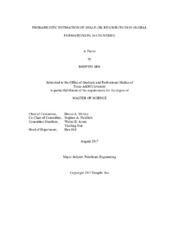| dc.description.abstract | An in-depth probabilistic study of global shale-oil resources is presently absent in
literature. In 2013, the Energy Information Agency (EIA) reported the total volumes of
shale oil available in 36 countries to be 388 billion barrels of oil (BBO) following a
volumetric assessment of several potentially shale-oil-rich global formations. However,
their study did not take into consideration the inherent heterogeneity of shale formations
and the resulting uncertainties in reservoir parameters used in the assessment.
I employed a probabilistic approach to the volumetric estimation of the original-in-place
shale oil (OOIPsh_oil) in 93 formations from these 36 countries (and the US)
belonging to seven geographical regions. This was followed by reservoir-simulation
studies of five US formations whereby generalized-recovery-factor (RF) distributions
were established for three values of hydraulic-fracture stage spacing. These generalized-
RF distributions were used to compute the technically-recoverable resources of shale oil
(TRRsh_oil) from the 93 formations considered. The results were aggregated to regional
and global levels assuming 100% dependence (arithmetic aggregation) as well as 100%
independence (statistical aggregation) between summand formation-wise resource
distributions.
The arithmetically-aggregated volumes (P10-P50-P90) of OOIPsh_oil in the
assessed global formations are 900-8,700-67,700 BBO (P90/P10 = 75), whereas the
arithmetically-aggregated volumes of TRRsh_oil, using 50-ft stage spacing, are computed
to be 25-374-3,906 BBO (P90/P10 = 159). Using statistical aggregation, the total volumes (P10-P50-P90) of OOIPsh_oil in the assessed global formations are 15,000-23,600-43,900 BBO (P90/P10 = 3), whereas the aggregated volumes of TRRsh_oil, using 50-ft stage spacing, are computed to be 250-1,300-3,100 BBO (P90/P10 = 12). The high values of P90/P10 highlight the large uncertainty in both arithmetically- and statistically aggregated estimates. Since true dependency between the resource distributions of
aggregated formations is unknown, the actual resource estimates are expected to fall
between the statistically- and arithmetically-aggregated estimates. Because this study
does not consider the uncertainties in, and possible correlations between, all variables,
the wider resources distributions from arithmetic aggregation may be deemed more
appropriate than from statistical aggregation.
This study accounts for only 41% of all global petroleum basins. Thus, actual
world resources are likely to be considerably larger. | en |


